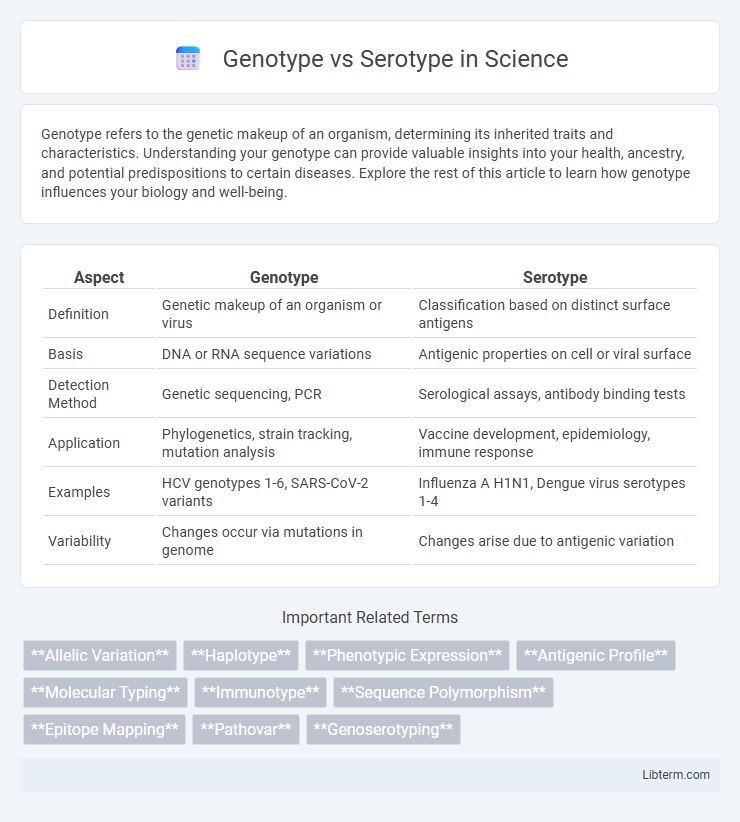Genotype refers to the genetic makeup of an organism, determining its inherited traits and characteristics. Understanding your genotype can provide valuable insights into your health, ancestry, and potential predispositions to certain diseases. Explore the rest of this article to learn how genotype influences your biology and well-being.
Table of Comparison
| Aspect | Genotype | Serotype |
|---|---|---|
| Definition | Genetic makeup of an organism or virus | Classification based on distinct surface antigens |
| Basis | DNA or RNA sequence variations | Antigenic properties on cell or viral surface |
| Detection Method | Genetic sequencing, PCR | Serological assays, antibody binding tests |
| Application | Phylogenetics, strain tracking, mutation analysis | Vaccine development, epidemiology, immune response |
| Examples | HCV genotypes 1-6, SARS-CoV-2 variants | Influenza A H1N1, Dengue virus serotypes 1-4 |
| Variability | Changes occur via mutations in genome | Changes arise due to antigenic variation |
Understanding Genotype: Definition and Importance
Genotype refers to the genetic constitution of an organism, representing the specific set of genes inherited from its parents. Understanding genotype is crucial for identifying genetic variations that influence traits, disease susceptibility, and response to treatments. This genetic blueprint underpins personalized medicine and advances in genetic research, distinguishing it from serotype, which classifies organisms based on antigenic properties.
What Is a Serotype? Key Characteristics Explained
A serotype is a classification of microorganisms based on their distinct surface antigens, such as lipopolysaccharides or flagellar proteins, which trigger specific immune responses. These antigens allow for precise identification and differentiation of bacterial strains, viruses, or other pathogens within a species, critical for diagnosis, epidemiology, and vaccine development. Unlike genotype, which refers to the genetic makeup, serotyping focuses on antigenic properties, providing insights into pathogen diversity and immune system interactions.
Genotype vs Serotype: Core Differences
Genotype refers to the genetic makeup of an organism, determined by its DNA sequence, while serotype classifies organisms based on their cell surface antigens detected by specific antibodies. Core differences between genotype and serotype lie in their identification methods: genotyping involves molecular techniques like PCR or sequencing to analyze genetic variations, whereas serotyping relies on immunological assays such as agglutination to detect antigenic properties. Understanding these distinctions is crucial for accurate pathogen classification, epidemiological studies, and developing targeted treatments or vaccines.
Methods for Determining Genotype
Genotyping methods primarily include polymerase chain reaction (PCR)-based techniques, such as real-time PCR and multiplex PCR, which amplify specific DNA regions to identify genetic variants. Sequencing methods like Sanger sequencing and next-generation sequencing (NGS) provide detailed information on nucleotide sequences, enabling precise genotype determination. Restriction fragment length polymorphism (RFLP) analysis and microarray hybridization are also employed to detect specific genetic markers associated with different genotypes.
Techniques for Identifying Serotype
Techniques for identifying serotypes primarily include serological methods such as slide agglutination and enzyme-linked immunosorbent assay (ELISA), which detect specific antigens on the surface of bacterial or viral cells. Molecular methods like PCR-based assays and whole-genome sequencing enable precise serotype determination by targeting genetic markers associated with antigenic variation. Advanced flow cytometry coupled with monoclonal antibodies offers high-throughput and accurate serotype identification in clinical and research settings.
Clinical Significance of Genotyping
Genotyping provides critical insights into pathogen variability by identifying specific genetic markers, enabling precise diagnosis and tailored treatment plans. Its clinical significance lies in guiding targeted therapies, monitoring disease outbreaks, and predicting drug resistance patterns. Compared to serotyping, genotyping offers higher resolution for understanding pathogen evolution and epidemiology.
Serotyping in Disease Diagnosis and Surveillance
Serotyping plays a crucial role in disease diagnosis and surveillance by identifying distinct variations within a species of bacteria or viruses based on their surface antigens, enabling targeted treatment and control measures. It provides essential epidemiological data that helps track the spread of infectious diseases, informing vaccine development and public health responses. Unlike genotyping, which analyzes genetic material, serotyping offers rapid, cost-effective identification of pathogens in clinical and environmental samples.
Genotype and Serotype in Vaccine Development
Genotype and serotype play crucial roles in vaccine development by determining pathogen diversity and immune response specificity. Genotyping identifies genetic variations within pathogen strains, enabling the design of vaccines targeting conserved genetic elements to enhance cross-protection. Serotyping classifies pathogens based on distinct surface antigens, guiding vaccine formulation to stimulate immunity against prevalent serotypes and reduce disease incidence.
Challenges in Differentiating Genotypes and Serotypes
Differentiating genotypes and serotypes poses significant challenges due to the genetic diversity and antigenic variability within microbial populations. Genotypes represent variations in the organism's genetic code identified through molecular techniques, while serotypes are classified based on distinct surface antigens detected by serological assays. The overlap between genetic markers and antigenic properties complicates accurate classification, demanding advanced sequencing technologies and comprehensive databases to improve diagnostic precision and epidemiological tracking.
Future Trends in Genotype and Serotype Research
Future trends in genotype and serotype research emphasize integrating high-throughput sequencing and advanced bioinformatics to enhance pathogen identification accuracy and outbreak tracking. Development of multiplex and point-of-care diagnostic tools aims to provide rapid genotype-serotype correlation, improving personalized treatment strategies and vaccine design. Artificial intelligence and machine learning are increasingly applied to predict evolutionary patterns and resistance mechanisms based on genotype-serotype data, transforming infectious disease management.
Genotype Infographic

 libterm.com
libterm.com